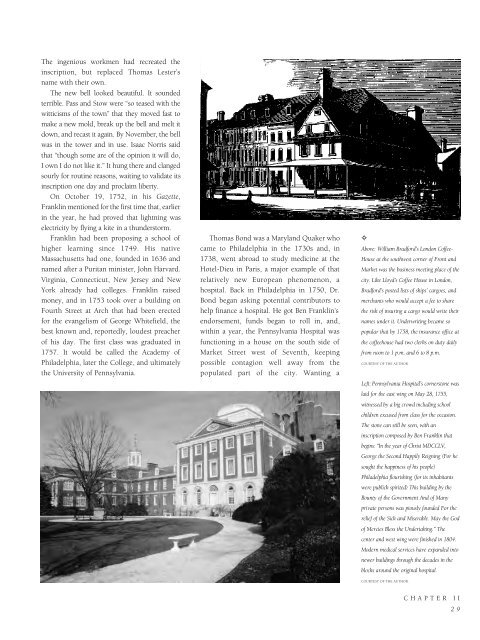Historic Philadelphia
An illustrated history of the city of Philadelphia, paired with the histories of companies, families and organizations that make the region great.
An illustrated history of the city of Philadelphia, paired with the histories of companies, families and organizations that make the region great.
You also want an ePaper? Increase the reach of your titles
YUMPU automatically turns print PDFs into web optimized ePapers that Google loves.
The ingenious workmen had recreated the<br />
inscription, but replaced Thomas Lester’s<br />
name with their own.<br />
The new bell looked beautiful. It sounded<br />
terrible. Pass and Stow were “so teased with the<br />
witticisms of the town” that they moved fast to<br />
make a new mold, break up the bell and melt it<br />
down, and recast it again. By November, the bell<br />
was in the tower and in use. Isaac Norris said<br />
that “though some are of the opinion it will do,<br />
I own I do not like it.” It hung there and clanged<br />
sourly for routine reasons, waiting to validate its<br />
inscription one day and proclaim liberty.<br />
On October 19, 1752, in his Gazette,<br />
Franklin mentioned for the first time that, earlier<br />
in the year, he had proved that lightning was<br />
electricity by flying a kite in a thunderstorm.<br />
Franklin had been proposing a school of<br />
higher learning since 1749. His native<br />
Massachusetts had one, founded in 1636 and<br />
named after a Puritan minister, John Harvard.<br />
Virginia, Connecticut, New Jersey and New<br />
York already had colleges. Franklin raised<br />
money, and in 1753 took over a building on<br />
Fourth Street at Arch that had been erected<br />
for the evangelism of George Whitefield, the<br />
best known and, reportedly, loudest preacher<br />
of his day. The first class was graduated in<br />
1757. It would be called the Academy of<br />
<strong>Philadelphia</strong>, later the College, and ultimately<br />
the University of Pennsylvania.<br />
Thomas Bond was a Maryland Quaker who<br />
came to <strong>Philadelphia</strong> in the 1730s and, in<br />
1738, went abroad to study medicine at the<br />
Hotel-Dieu in Paris, a major example of that<br />
relatively new European phenomenon, a<br />
hospital. Back in <strong>Philadelphia</strong> in 1750, Dr.<br />
Bond began asking potential contributors to<br />
help finance a hospital. He got Ben Franklin’s<br />
endorsement, funds began to roll in, and,<br />
within a year, the Pennsylvania Hospital was<br />
functioning in a house on the south side of<br />
Market Street west of Seventh, keeping<br />
possible contagion well away from the<br />
populated part of the city. Wanting a<br />
✧<br />
Above: William Bradford’s London Coffee-<br />
House at the southwest corner of Front and<br />
Market was the business meeting place of the<br />
city. Like Lloyd’s Coffee House in London,<br />
Bradford’s posted lists of ships’ cargoes, and<br />
merchants who would accept a fee to share<br />
the risk of insuring a cargo would write their<br />
names under it. Underwriting became so<br />
popular that by 1758, the insurance office at<br />
the coffeehouse had two clerks on duty daily<br />
from noon to 1 p.m. and 6 to 8 p.m.<br />
COURTESY OF THE AUTHOR.<br />
Left: Pennsylvania Hospital’s cornerstone was<br />
laid for the east wing on May 28, 1755,<br />
witnessed by a big crowd including school<br />
children excused from class for the occasion.<br />
The stone can still be seen, with an<br />
inscription composed by Ben Franklin that<br />
begins: “In the year of Christ MDCCLV,<br />
George the Second Happily Reigning (For he<br />
sought the happiness of his people)<br />
<strong>Philadelphia</strong> flourishing (for its inhabitants<br />
were publick spirited) This building by the<br />
Bounty of the Government And of Many<br />
private persons was piously founded For the<br />
relief of the Sick and Miserable. May the God<br />
of Mercies Bless the Undertaking.” The<br />
center and west wing were finished in 1804.<br />
Modern medical services have expanded into<br />
newer buildings through the decades in the<br />
blocks around the original hospital.<br />
COURTESY OF THE AUTHOR.<br />
CHAPTER II<br />
29
















